Intel Teases Comet Lake-H, Ghost Canyon NUCs, and Tiger Lake Processors

Intel held its Performance Workshop here in Las Vegas at CES 2020 to brief the press on a few new announcements, including the pending arrival of the Comet Lake-H processors for laptops, which will reach over 5.0 GHz and feature up to eight cores and 16 threads, a few vague details of the Tiger Lake processors' AI performance, and our first official glimpse of the NUC 9 Extreme "Ghost Canyon NUC." Intel will also announce an expansion of the Project Athena program tomorrow during its keynote.
As expected, Intel also presented some of its own internal benchmarks of its existing mobile processors against several competing AMD chips. Intel tells us that it will reveal more details about the NUC over the coming days, and more information on the forthcoming Comet Lake-H and Tiger Lake processors this week, but we do have a few things to cover for now. Unfortunately, that doesn't include any new revelations about new desktop PC chips, namely the long-awaited Comet Lake-S models.
Intel's 10th-Gen H-Series Expansion
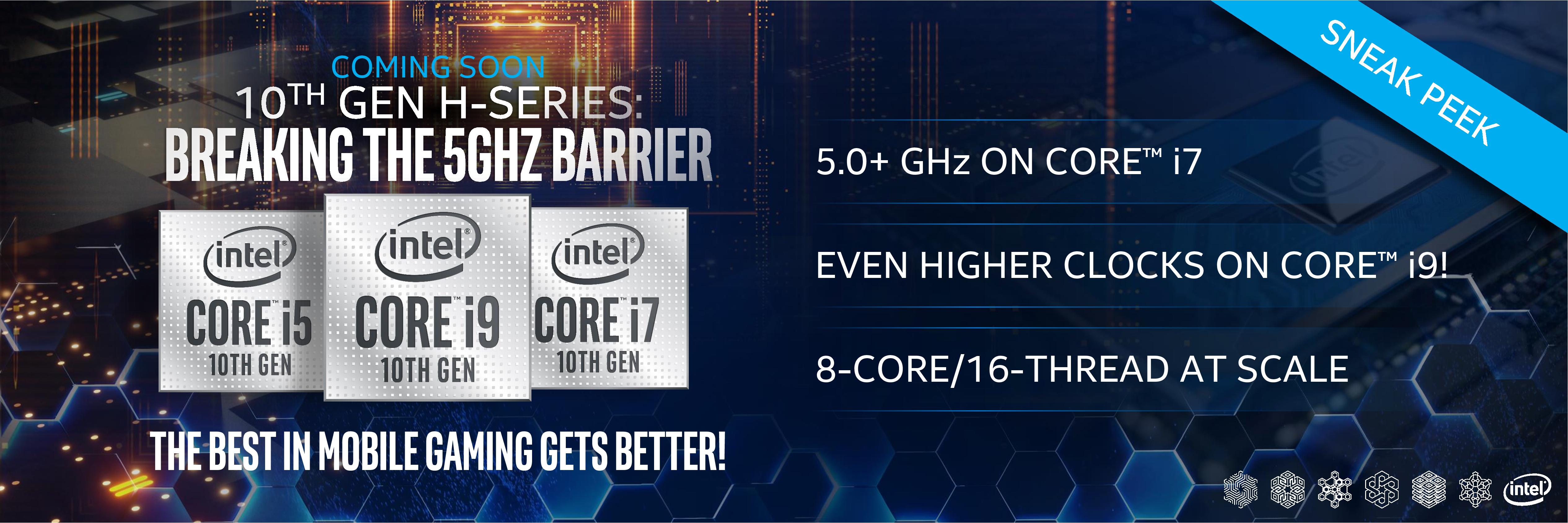
Intel's headline announcement is that it will expand the 10th-Gen Comet Lake mobile processor family to include H-Series models with up to eight-cores 16-threads, with the Core i7 SKUs reaching up to 5GHz while the Core i9 models will stretch up "even higher." The company tells us these processors will launch soon, but hasn't provided a firm launch date.
Intel already split its 10th-Gen lineup of laptop processors into 14nm Comet Lake models positioned for productivity and creativity workloads with up to six cores, while the 10nm Ice Lake models feature a beefier Gen 11 graphics engine that is better suited for gaming without a discrete GPU. However, the Ice Lake processors operate at lower clock frequencies, which results in lower performance in some workloads, and those models only span up to four cores.
The new 45W H-series processors land with the 14nm process and the Comet Lake architecture, which isn't entirely surprising given Intel's continuing challenges with the 10nm node. Due to the maturity of the 14nm process, the H-Series processors will feature the fastest clock speeds in the company's 10th-gen lineup, but Intel hasn't specified the graphics engine. It's safe to assume the Comet Lake chips will arrive with the same Intel Iris Plus graphics engine that isn't nearly as capable as the Gen11 graphics found on the Ice Lake models, which means there will still be a split in the company's mobile portfolio between chips geared for compute workloads and those for gaming on integrated graphics.
That isn't too much of a problem for the H-Series processors due to their focus on high-performance laptops with discrete graphics solutions. Like other 10th-Gen mobile platforms, we can expect to see systems with Wi-Fi 6, Thunderbolt 3, and support for Optane Memory.
Intel hasn't revealed the actual launch date of its 10th-gen H-series processors yet, but we expect them to land in time to fend off AMD's Ryzen 4000-series "Renoir" APUs, which are also expected to feature eight cores and 16 threads but come with AMD's Zen architecture paired with an integrated graphics engine (rumored to be Vega).
Get Tom's Hardware's best news and in-depth reviews, straight to your inbox.
AMD's new chips should help the company become more competitive against Intel's processors in both performance and battery life, with the latter being a sore point for the current-gen mobile Ryzen 3000 chips. The jury is still out on how well the AMD chips will fare against Intel's processors when paired with a discrete graphics card. With little to no information being official at this point, its hard to determine how the two lines will stack up, but we'll learn more during AMD CEO Lisa Su's press conference tomorrow.
10nm Tiger Lake AI Performance
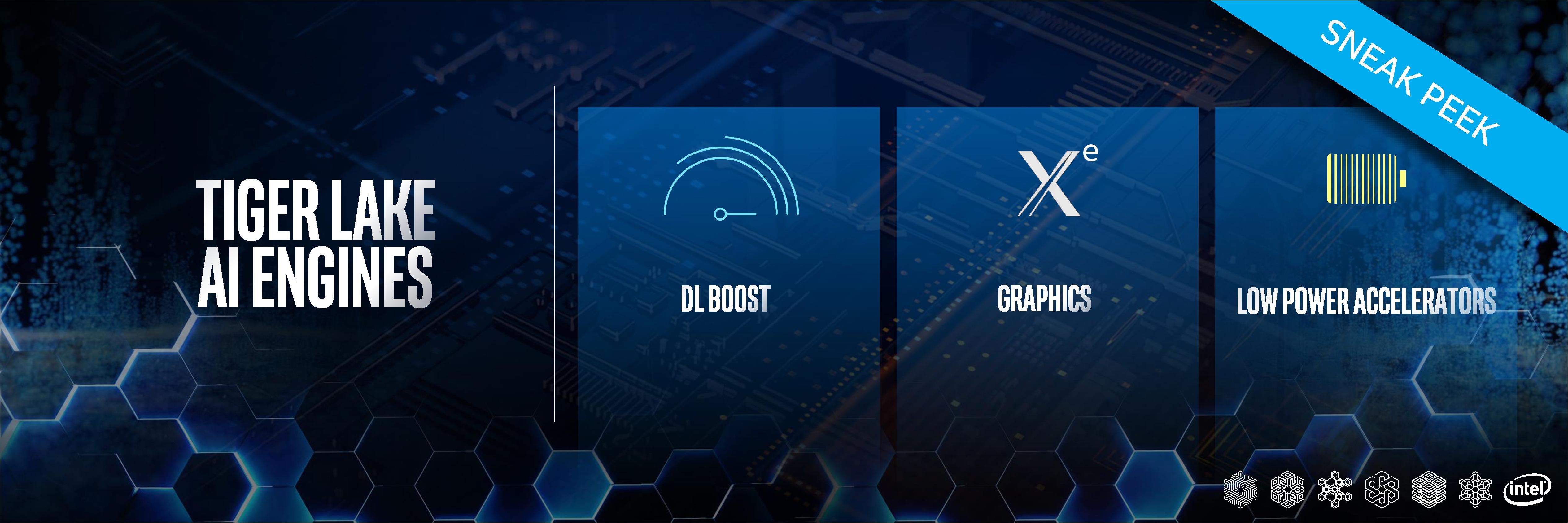
Intel provided more information on its AI initiatives, including a vague claim that AI performance will improve with its Tiger Lake processors due to improvements to the company's three-engine AI subsystem. The Tiger Lake processors will feature faster DL Boost and inference engines that run in the execution cores and Xe graphics engines, respectively. Intel also said the AI engine embedded in the chipset will get an update to a new second-gen solution, but didn't share any performance metrics or hard data to back up the claims. We're told the company will announce more details at its keynote tomorrow.
Intel's transition to the 10nm process has been painful as it has worked through several iterations of the silicon in a struggle to create a node that was both performant and had high enough yield rates to be produced economically. Due to those challenges, the Ice Lake chips have lower frequencies than the previous-gen models, but Intel made up for the reduced clock speeds with architectural gains that brought an average IPC increase of 18%.
The new 10nm Tiger Lake chips should come with an even newer architecture and higher clock rates borne of the next step on the 10nm process (10nm++). According to Intel's official announcements, the Tiger Lake processors will span up to 25W. According to a recent processor dump posted to chip analyst @InstLatX64's account, Tiger Lake-U will feature a 50% increase in L3 cache capacity, going from 8MB to 12MB, for a total of 3MB per core. The chips also support AVX-512 and are expected to come with Intel's Willow Cove cores and Intel's Gen12 Xe graphics.
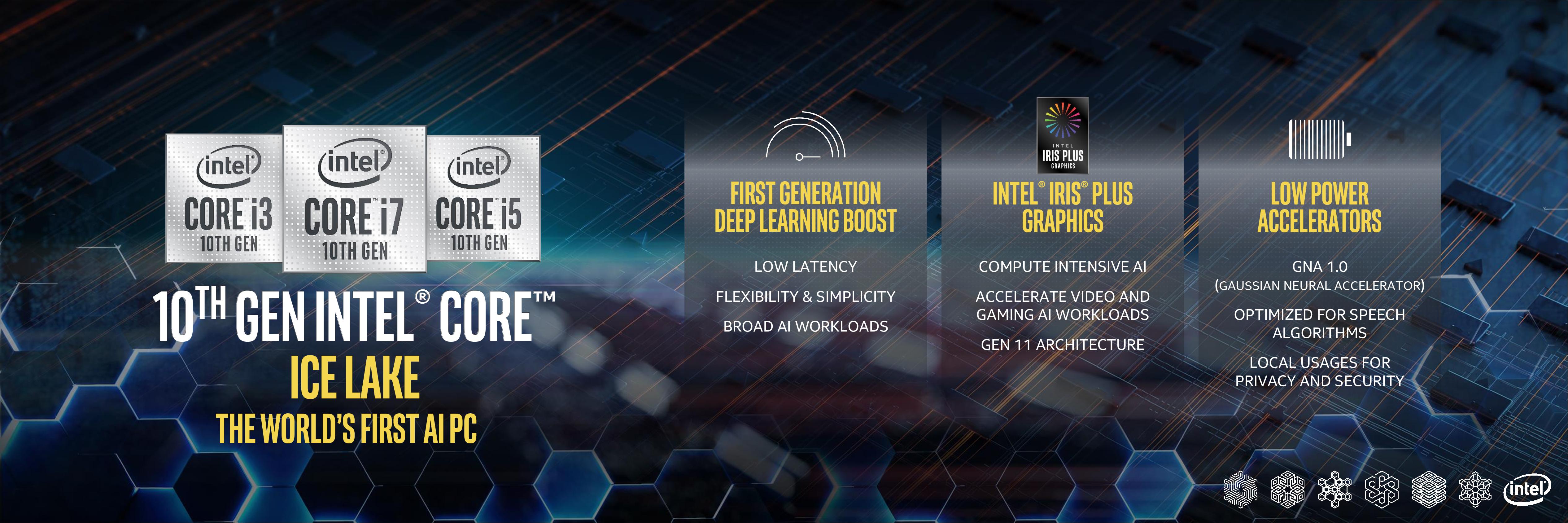










Intel re-explained some of the finer aspects of its AI implementation and touted the increasing ecosystem of software that supports AI acceleration, like Adobe Photoshop and Lightroom, CyberLink, Topaz Labs and Cyber Labs, not to mention several of Intel's own software solutions. The increasing breadth of AI-accelerated software marks significant progress compared to the initial Ice Lake launch when only a few applications supported the faster processing format.
Intel did tell us that Tiger Lakes Gen12 Xe graphics engine will now have hardware acceleration for INT8, which is becoming the go-to numerical format for low-precision AI operations. That should unlock more performance from the graphics engine, which is used primarily for sustained and periodic workloads, while the unspecified enhancements to the DL Boost engine will bring about AI performance improvements on the CPU cores for bursty workloads. Meanwhile, low-power audio processing tasks will still be addressed by the chipset, but an improved AI accelerator engine should bring about improved performance.
As we would expect, Intel pressed the point that AMD doesn't have any hardware-accelerated AI features for its silicon. AMD's lack of optimizations isn't surprising given its stated preference to be a fast-follower with some types of instructions, like AVX-512, thus allowing each type of new use case, and the surrounding software ecosystem, to mature before infusing support into its hardware. As we can see, Intel is still in the midst of leading the charge to AI on desktop and laptop platforms, but the software ecosystem is taking some time to mature. Given AMD's lack of hardware-based solutions, the Intel benchmarks of a competing AMD processor trail significantly, but as with all vendor-provided benchmarks, take these with a grain of salt and be sure to check the test notes we've posted at the end of the article.
Intel Extreme NUC 9 "Ghost Canyon NUC"





Intel also unveiled its NUC 9 Extreme "Ghost Canyon" systems that completely redefine what we've come to expect from NUCs, though the traditional NUC form factors (i.e, the small PCs) will co-exist with the new design. Intel opened this new design up to its partners, so we will see customized iterations come to market.
The NUC has a much larger chassis that essentially serves as a housing for a backplane with two PCIe slots. Inside, an installable compute module (the "Element") that houses the processor, I/O, and memory slots into a standard PCIe slot. The initial revisions come with 9th-Gen mobile processors topping out at eight cores, but we're told that newer versions will come to market in due time. Due to the new design and the fact that the compute module is essentially a complete system, users can simply swap in a new module to perform an upgrade.
The chassis also supports standard desktop form-factor GPUs, but only up to eight inches in length. As such, we can expect a wave of new discrete GPUs tailored for Intel's NUCs to arrive in the coming months. Intel also plans to divulge more information about the NUCs at a workshop this week, so we'll have all of the official deep-dive details soon.
In the meantime, A Chinese user from the KoolShare forums has already reviewed and dismantled an engineering sample of the Ghost Canyon NUC. The Intel NUC 9 Extreme's 5-liter chasis measures 238 x 216 x 96mm (L x W x H) and is the chipmaker's largest NUC yet. According to the teardown, Intel will reportedly offer three 45W processor options that span from four cores up to eight cores. You can pick between the Core i9-9980HK, Core i7-9750H and Core i5-9300H. That means the NUC will support chips up to 5GHz and eight cores.
The NUC's front panel houses the power button, SD card reader, two USB 3.1 Gen 2 Type-A ports, and a single 3.5mm audio jack. The device features honeycomb side panels that allow fresh air to enter from both sides to cool off the internal components. Furthermore, Intel has placed a pair of 80mm cooling fans up top to expel the hot air from the NUC.
The integrated PSU weighs in at 500W and is located at the bottom of the NUC and feeds the compute element with an 8-pin PCIe connector. You can see more details here.
Intel's Benchmark Extravaganza...of Existing Chips







Intel also presented plenty of benchmarks as part of its ongoing focus on 'real-world performance,' but given that we're in an odd period inbetween launches of the competing mobile platforms, these benchmarks merely tout performance numbers from existing chips. That isn't too exciting, and there's already plenty of third-party testing in the wild of many of these same platforms.
For reference, in one series of tests, Intel tested the Ryzen 7 3750H with an RTX 2060 against its own Core i7-9750H paired with and RTX 2060 and the Core i9-9980HK paired with an RTX 2080. Intel says it couldn't find an OEM system with a Ryzen 7 3750H paired with a RTX 2080 GPU, which the company says highlights that vendors only build their most premium gaming solutions with Intel silicon. There is a tremendous pricing difference between these platforms, so this is most definitely not apples-to-apples, but Intel aims to underline that it has processors that are in a class of their own for mobile gaming. It'll be interesting to see if that changes with the Ryzen 4000-series lineup. We've included the test notes in the album below for your perusal.
We expect much more to come during the company's CES 2020 keynote tomorrow, not to mention during AMD CEO Lisa Su's press conference. Stay tuned.

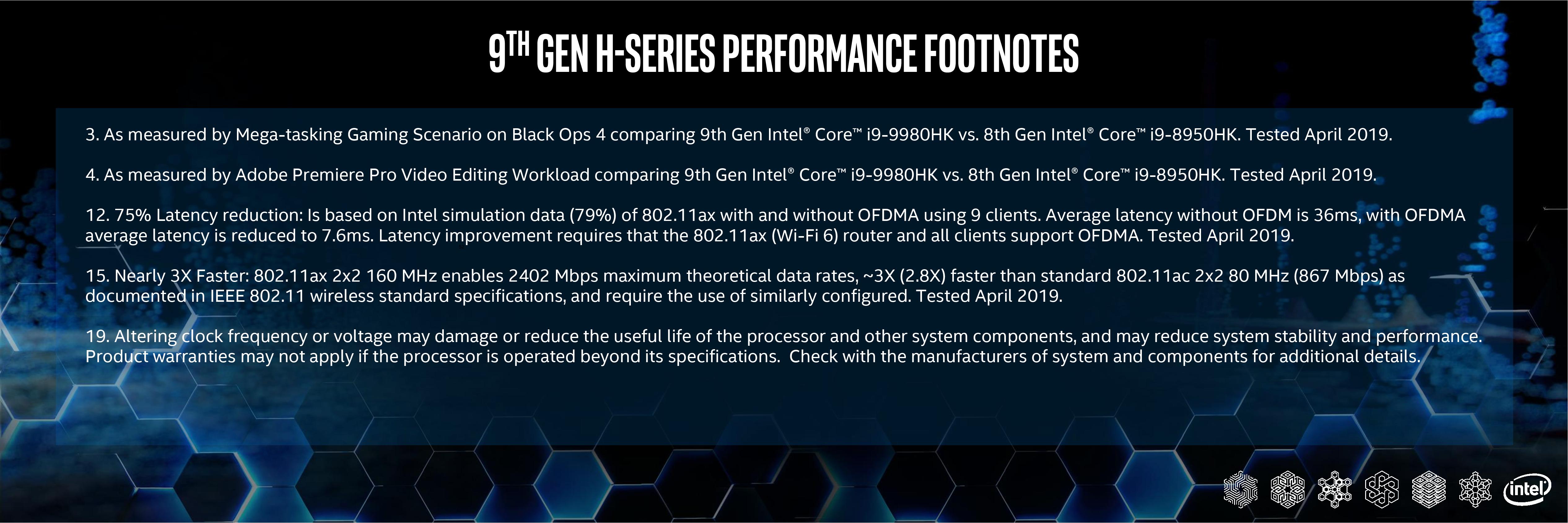
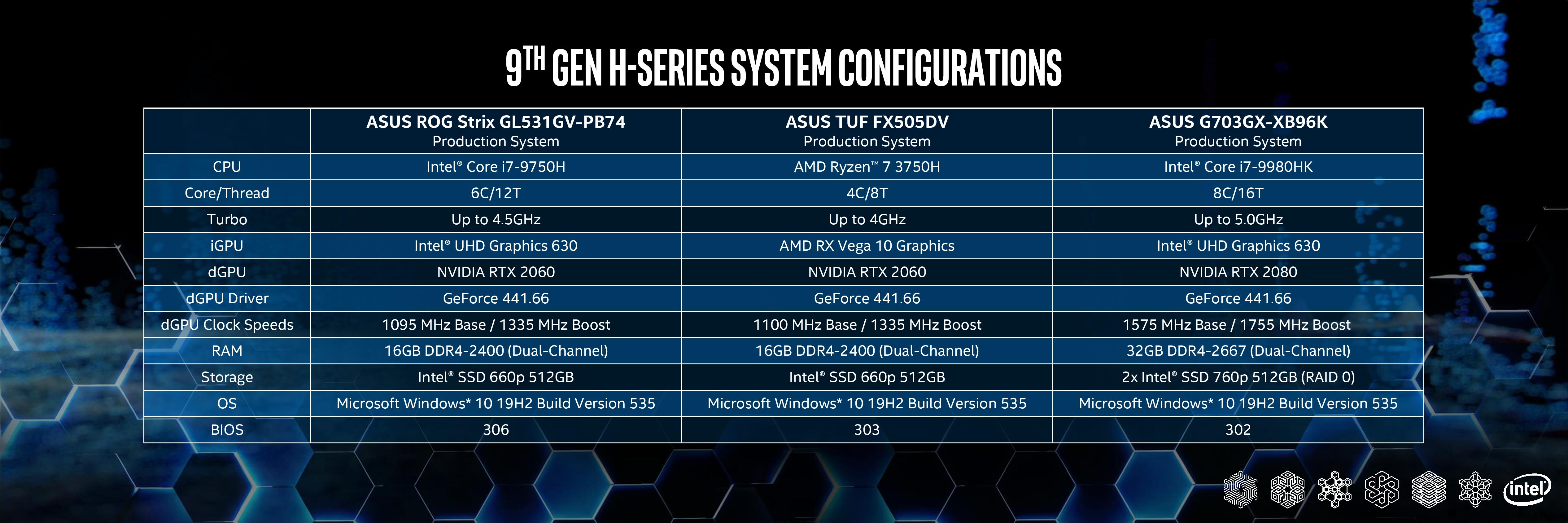






Paul Alcorn is the Editor-in-Chief for Tom's Hardware US. He also writes news and reviews on CPUs, storage, and enterprise hardware.
-
hotaru251 5ghz in a laptop....for how long? 10sec or less?Reply
everyone knows how bad laptop cooling is and never allow chips to run at those speeds for long. -
lipaopao000 Reply
yeah, you are right but at least it's betterhotaru251 said:5ghz in a laptop....for how long? 10sec or less?
everyone knows how bad laptop cooling is and never allow chips to run at those speeds for long. -
gggplaya That's "NUC" is huge. I'd rather build a ryzen mini ITX PC with the 3700x 65wtdp processor. There are some really small cases out there in mini ITX. In all likelyhood, this NUC may not keep a multicore boost much higher than the 3700x anyways (like 200-300mhz).Reply -
jimmysmitty Replygggplaya said:That's "NUC" is huge. I'd rather build a ryzen mini ITX PC with the 3700x 65wtdp processor. There are some really small cases out there in mini ITX. In all likelyhood, this NUC may not keep a multicore boost much higher than the 3700x anyways (like 200-300mhz).
Most mITX cases are still much larger than this and this is a NUC designed with the idea of being able to have a full sized dGPU in it. -
gggplaya Replyjimmysmitty said:Most mITX cases are still much larger than this and this is a NUC designed with the idea of being able to have a full sized dGPU in it.
Looks about the same size as a DANcase A4 which is 8 x 12 x 4.5 inches.
If you're on a budget, you can get a Cougar QBX which is 10 x 15 x 7 inches which is a little bigger and thicker than this, but still perfectly at home next to your TV or uncluttered desktop.
The Ryzen 4000 APU on 7nm will have an 8 core 16 thread variant, supposedly, paired with a vega GPU with more CU's. I'll be interesting to see how it performs compared to this NUC but in a smaller package without a dGPU. -
jimmysmitty Replygggplaya said:Looks about the same size as a DANcase A4 which is 8 x 12 x 4.5 inches.
If you're on a budget, you can get a Cougar QBX which is 10 x 15 x 7 inches which is a little bigger and thicker than this, but still perfectly at home next to your TV or uncluttered desktop.
The Ryzen 4000 APU on 7nm will have an 8 core 16 thread variant, supposedly, paired with a vega GPU with more CU's. I'll be interesting to see how it performs compared to this NUC but in a smaller package without a dGPU.
That a SFX case though not mITX. SFW is smaller but also more limited.
It will be interesting if AMD ever comes out to compete with Intels NUCs. I like them personally. I built my grandmother a NUC based PC that was no larger than a can on soda and mounted it to the back of a monitor making it a nice little AiO style PC. -
Brian_R170 Replygggplaya said:Looks about the same size as a DANcase A4 which is 8 x 12 x 4.5 inches.
The NUC is slighty under 5.0L. The DAN case is slightly over 7.5L. That might not not seem like a big difference if you're coming from a 60-liter ATX tower, but besides the Dan A4 being 50% larger than the NUC, a volume difference of 2.5L is a huge in the realm of small form-factor chassis. -
JayNor Intel NUC 9 Extreme's 5-liter chasis measures 238 x 216 x 96mm (L x W x H)Reply
https://www.tomshardware.com/news/intel-teases-comet-lake-h-ghost-canyon-nucs-and-tiger-lake-processors